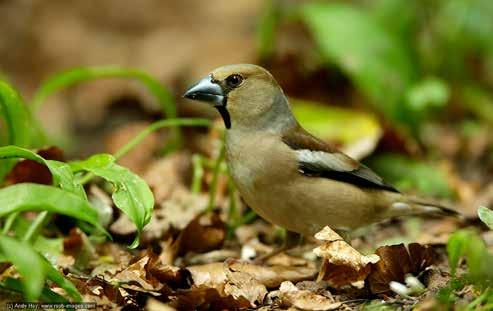
4 minute read
Understanding Hawfinch declines..................................................Will Kirby
Will Kirby, Conservation Scientist, RSPB Centre for Conservation Science
Understanding Hawfinch declines – Saving Species
Research carried out between 2012 and 2016 has revealed new findings about Hawfinch habitat preferences, foraging and breeding behaviour and nest survival. Radio tracking and nest monitoring are providing the scientific basis required to devise actions that could help reverse the decline of this bird of conservation concern.
Hawfinch in decline in the UK
Weighing around 50g , the Hawfinch is the UK’s largest finch, over twice the weight of the more familiar Chaffinch. With large declines in numbers and a severe contraction in breeding range, the Hawfinch is on the Red List of Birds of Conservation Concern and the latest estimate suggests there may be fewer than one thousand breeding pairs remaining in Britain. Importance of woodland
RSPB Centre for Conservation Science began research into possible causes of Hawfinch declines in 2012. The first part of the study focused on assessing whether habitat at landscape and local scale was linked to population declines. National Bird Atlas data from the British Trust for Ornithology were used to compare areas where breeding Hawfinch had been lost, with those where they remained. The main finding (perhaps unsurprisingly) was that they are more likely to have persisted in landscapes with a high proportion of mature, broadleaved woodland. Within woodland they preferred nest sites close to glades and tracks over densely wooded areas. Radio tracking
Since 2013, our study has focused on breeding ecology in an attempt to establish whether poor nesting success could be the reason behind population declines. Finding Hawfinch nests is extremely difficult as they are usually sited high up in the tree canopy. In addition to this, the adult birds
are not particularly territorial or vocal and there aren’t many of them. To help us find a reasonable sample, we teamed up with bird ringers in the Forest of Dean and North Wales during the pre-breeding season. This enabled us to fit radio-tags to females and, by tracking the signals, to locate their nests once they begin incubating their eggs. Although this sounds easy, it has proved a steep learning curve with many problems including loss and damage of tags, and the long distances travelled by the birds which sometimes took them outside of the study areas and into difficult terrain.
Monitoring methods
By refining techniques through experience, we have managed to find and monitor over 50 nests from 2013-2016. Nests can be built in any tree species and heights range from 3m to 30m from the ground. Once they have been located, we generally monitor them from the ground using a telescope. However, this limits the information that can be collected as it is not usually possible to see into the nest and we have to rely on adult behaviour to infer what is happening. In some instances, trained climbers have been able to install cameras to view inside the nest, allowing for much more detailed monitoring. Nest predation
Nest monitoring has revealed the number of young birds hatching and fledging as well as the causes of nest failure, which have included poor weather and predation by Jays, Crows, Goshawks and Great Spotted Woodpeckers. Interestingly, there have been no recorded instances of grey squirrel predation, despite these being common within the study woods. In addition to measuring breeding success, we have had new insights into Hawfinch breeding behaviour, including evidence that they can have two successful nesting attempts in the same season. Females have also been recorded moving several kilometres to re-nest in a different wood after a nest fails.
Future plans – GPS tracking
Whilst tracking females to locate nest sites, we have learned that Hawfinches move more widely than was previously thought and to investigate this further we are trialling the use of miniature GPS trackers weighing just 1g. In the latter part of the 2016 breeding season, we attached a small number of GPS tags to Hawfinches. These tags store information about the birds location at hourly intervals during the day using information from Global Positioning Satellites and can track the birds’ movements over the course of several days. The recovery of our first tag has provided data for the first detailed map of Hawfinch movements, confirming the wide use of the landscape in their daily foraging activity. Over the course of five days, the tagged bird was recorded in 12 different 1km squares and a range of habitats, including woodland, farmland hedgerows and gardens. We hope that further use of GPS tags next year will provide evidence of important food resources available at different times of the year and help establish the foraging range of adults feeding nestlings. This will provide us with key information for the design of future conservation measures.
This work is funded by the Action for Birds in England partnership between RSPB and Natural England, work which would not be possible without the input from many other individuals and organisations which provide access to woods and help with fieldwork.










